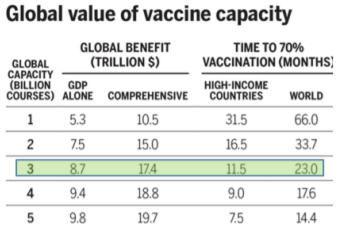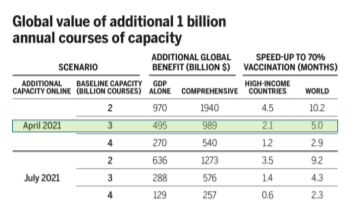- | Federal Testimonies Federal Testimonies
- |
Vaccinations and the Economic Recovery in 2021
Joint Economic Committee
Thank you all for inviting me it’s a pleasure to be here. About a year ago, Nobel Prize winner Michael Kremer and I were asked by the Domestic Policy Council of the White House to write a report about accelerating vaccines using incentives. Joined by a number of top economists, we advocated for world spending on the order of ~$150 billion to invest in approximately 18 vaccine candidates. We wrote similar reports for the British government and subsequently came to advise the World Bank and other governments and organizations around the world.
The world did not go as big as we wanted but Operation Warp Speed spent about $15 billion and was tremendously successful.
In a paper in Science we calculate that if we get 3 billion vaccine courses in 2021, which is a conservative estimate, that they will be worth $17.4 trillion dollars and OWS should be credited with, certainly not all, but a significant faction of that.
Moreover, it is not too late to do more. We calculate that an additional 1 billion courses of capacity available in 2021 would be worth 500 bn to 1 trillion dollars for the world depending on how fast we can get that capacity online.
Is it possible to get more doses this year? Yes. For example, the Biden administration paid Merck $269 million to upgrade plants to produce the J&J vaccine. That was a smart investment that will pay off not just for the US but for the entire world.
Another smart investment would be to put more money into Nasal and Oral vaccines. The next battle is vaccine hesitancy and a lot of vaccine hesitancy is fear of needles. Adults don’t like to say that they are afraid of needles but many are. Nasal vaccines, therefore, could do a lot to alleviate vaccine hesitancy and nasal vaccines have advantages in uniquely stimulating the mucosal immune system. There are nasal vaccines in phase 1 clinical trials and the US could accelerate these with investments in trials and manufacturing.
Once the US is vaccinated, the next job is to vaccinate the world. There are health, economic and political reasons to vaccinate the world.
The unvaccinated are the biggest risk for generating mutations and new variants. You have heard of the South Africa and Brazilian variants, well the best way to protect your constituents from these and other variants is to vaccine South Africans and Brazilians.
Moreover, even after the US and other high-income countries are vaccinated the US will continue to bear economic costs due to reduced exports, imports and supply-chain disruptions so there are pure economic reasons to vaccinate the world.
The US could significantly advance world vaccination with an additional $4bn support for COVAX. The benefits are much bigger the costs (see Agarawal and Reed in attachments).
Politically we also have a choice, do we want an American Plan to vaccinate the world or a Chinese Plan? I would rather have an American plan.
As we vaccinate the world we should think about ways to stretch doses until scarcity is ended.
For example, the first Pfizer or Moderna dose protects at about 80% efficacy (see Canadian Statement and NEJM letter in attachments). It is better in my view to bring two people from 0% protected to 80% protected than to bring one person to 80% and then to 95% protected. Loosely speaking, the first dose prevents you from dying, the second dose avoids the sniffles.
Getting more first doses out sooner will also reduce transmission and get us to herd immunity sooner.
We should also run trials on fractional dosing, such as half dosing. Fractional dosing has been used successfully in previous epidemics.
Note that half dosing is equivalent to doubling the number of Pfizer and Moderna factories instantly! And hence potentially very valuable. Variations are possible such as half-dosing on the second dose.
Great Britain and Canada have delayed the second dose and other countries will likely follow suit— stretching doses will be important to vaccinate the world quickly.
Summing up.
It is not too late to do more.
We should invest in nasal vaccines.
We should vaccinate the world.
We should stretch doses through fractional dosing and delaying the second dose.
Thank you.
Exhibits


Castillo, Juan Camilo, Amrita Ahuja, Susan Athey, Arthur Baker, Eric Budish, Tasneem Chipty, Rachel Glennerster, et al. 2021. “Market Design to Accelerate COVID-19 Vaccine Supply.” Science, February. https://doi.org/10.1126/science.abg0889.
Attachments
Canadian statement on delaying the second dose.
National Advisory Committee on Immunization (NACI) Canada. 2021. “COVID-19 Vaccine Extended Dose Interval for Canadians: NACI Recommendation.” Government of Canada. March 3, 2021. https://www.canada.ca/en/public-health/services/immunization/national-advisory-committee-onimmunization-naci/rapid-response-extended-dose-intervals-covid-19-vaccines-early-rollout-populationprotection.html.
Value of vaccine capacity and additional investments.
Castillo, Juan Camilo, Amrita Ahuja, Susan Athey, Arthur Baker, Eric Budish, Tasneem Chipty, Rachel Glennerster, et al. 2021. “Market Design to Accelerate COVID-19 Vaccine Supply.” Science, February. https://doi.org/10.1126/science.abg0889.
Efficacy of the first dose from NEJM.
Skowronski, Danuta, and Gaston Serres De. 2021. “Letter to the Editor on Safety and Efficacy of the BNT162b2 MRNA Covid-19 Vaccine.” New England Journal of Medicine, February 17, 2021. https://doi.org/10.1056/NEJMc2036242.
Overview of dose stretching policies with links in online version.
Tabarrok, Alex. 2021. “What Are We Waiting For?” Washington Post, February 12, 2021, sec. Outlook. https://www.washingtonpost.com/outlook/2021/02/12/first-doses-vaccine-rules-fda/
A plan to vaccinate the world.
Agarwal, Ruchir, and Tristan Reed. 2021. “How to End the COVID-19 Pandemic by March 2022” Google Docs. 2021. https://drive.google.com/file/d/1lN7qVVOoUkqCvOO6ldeuAZnmkEHp127I/view.

